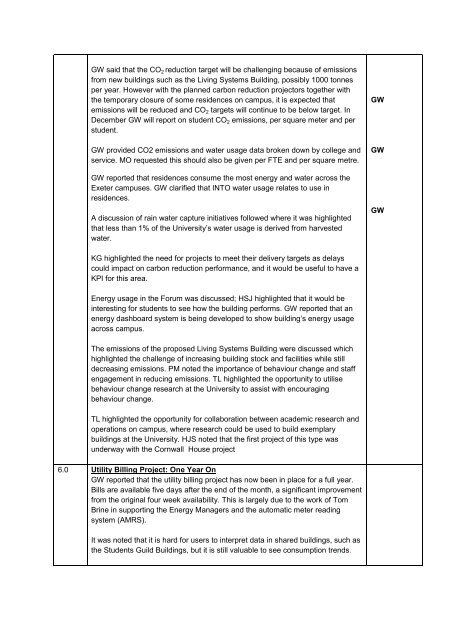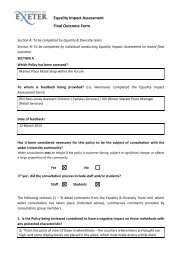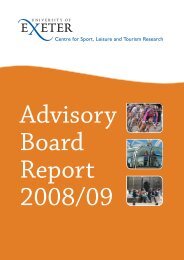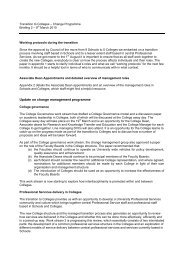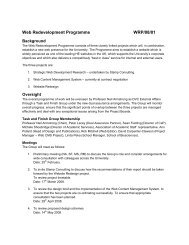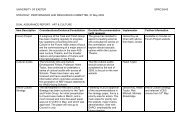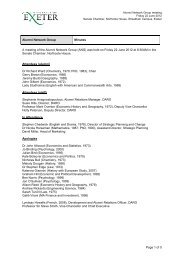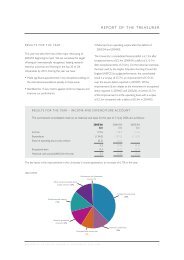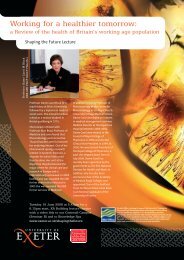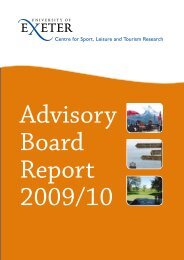25 September 2012 - University of Exeter
25 September 2012 - University of Exeter
25 September 2012 - University of Exeter
Create successful ePaper yourself
Turn your PDF publications into a flip-book with our unique Google optimized e-Paper software.
GW said that the CO2 reduction target will be challenging because <strong>of</strong> emissions<br />
from new buildings such as the Living Systems Building, possibly 1000 tonnes<br />
per year. However with the planned carbon reduction projectors together with<br />
the temporary closure <strong>of</strong> some residences on campus, it is expected that<br />
emissions will be reduced and CO2 targets will continue to be below target. In<br />
December GW will report on student CO2 emissions, per square meter and per<br />
student.<br />
GW provided CO2 emissions and water usage data broken down by college and<br />
service. MO requested this should also be given per FTE and per square metre.<br />
GW reported that residences consume the most energy and water across the<br />
<strong>Exeter</strong> campuses. GW clarified that INTO water usage relates to use in<br />
residences.<br />
A discussion <strong>of</strong> rain water capture initiatives followed where it was highlighted<br />
that less than 1% <strong>of</strong> the <strong>University</strong>’s water usage is derived from harvested<br />
water.<br />
KG highlighted the need for projects to meet their delivery targets as delays<br />
could impact on carbon reduction performance, and it would be useful to have a<br />
KPI for this area.<br />
Energy usage in the Forum was discussed; HSJ highlighted that it would be<br />
interesting for students to see how the building performs. GW reported that an<br />
energy dashboard system is being developed to show building’s energy usage<br />
across campus.<br />
The emissions <strong>of</strong> the proposed Living Systems Building were discussed which<br />
highlighted the challenge <strong>of</strong> increasing building stock and facilities while still<br />
decreasing emissions. PM noted the importance <strong>of</strong> behaviour change and staff<br />
engagement in reducing emissions. TL highlighted the opportunity to utilise<br />
behaviour change research at the <strong>University</strong> to assist with encouraging<br />
behaviour change.<br />
TL highlighted the opportunity for collaboration between academic research and<br />
operations on campus, where research could be used to build exemplary<br />
buildings at the <strong>University</strong>. HJS noted that the first project <strong>of</strong> this type was<br />
underway with the Cornwall House project<br />
6.0 Utility Billing Project: One Year On<br />
GW reported that the utility billing project has now been in place for a full year.<br />
Bills are available five days after the end <strong>of</strong> the month, a significant improvement<br />
from the original four week availability. This is largely due to the work <strong>of</strong> Tom<br />
Brine in supporting the Energy Managers and the automatic meter reading<br />
system (AMRS).<br />
It was noted that it is hard for users to interpret data in shared buildings, such as<br />
the Students Guild Buildings, but it is still valuable to see consumption trends.<br />
GW<br />
GW<br />
GW


